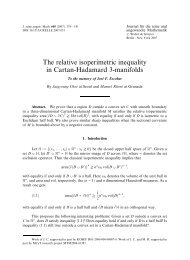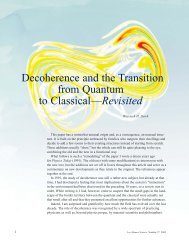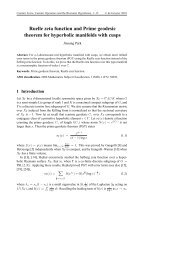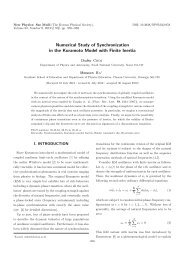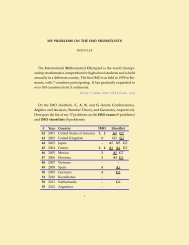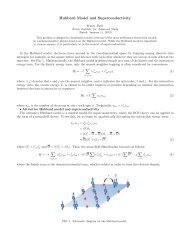A Quantum Kirwan Map: Bubbling and Fredholm Theory for ... - KIAS
A Quantum Kirwan Map: Bubbling and Fredholm Theory for ... - KIAS
A Quantum Kirwan Map: Bubbling and Fredholm Theory for ... - KIAS
Create successful ePaper yourself
Turn your PDF publications into a flip-book with our unique Google optimized e-Paper software.
CHAPTER 2<strong>Bubbling</strong> <strong>for</strong> vortices over the planeIn this chapter, stable maps consisting of vortex classes over the plane C, holomorphicspheres in the symplectic quotient, <strong>and</strong> marked points, are defined, <strong>and</strong>the first main result of this memoir, Theorem 3, is proven. This result states thatgiven a sequence of vortex classes over C, with uni<strong>for</strong>mly bounded energies, <strong>and</strong>sequences of marked points, there exists a subsequence that converges to some stablemap. We also describe stable maps <strong>and</strong> convergence in the simplest interestingexample, the Ginzburg-L<strong>and</strong>au setting.2.1. Stable mapsLet M,ω,G,g, 〈·, ·〉 g ,µ,J be as in Chapter 1. Our st<strong>and</strong>ing hypothesis (H)implies that the symplectic quotient(M = µ −1 (0)/G,ω )is well-defined <strong>and</strong> closed. The structure J induces an ω-compatible almost complexstructure on M as follows. For every x ∈ M we denote by L x : g → T x M theinfinitesimal action at x. We define the horizontal distribution H ⊆ T(µ −1 (0)) byH x := kerdµ(x) ∩ imL ⊥ x , ∀x ∈ µ −1 (0).Here ⊥ denotes the orthogonal complement with respect to the metric ω(·,J·) onM. We denote by π : µ −1 (0) → M := µ −1 (0)/G the canonical projection. Wedefine ¯J to be the unique isomorphism of TM such that(2.1) ¯J dπ = dπJ on H.1We identify C ∪ {∞} with S 2 . The (Connectedness) condition in the definitionof a stable map below will involve the evaluation of a vortex class at the point∞ ∈ S 2 . In order to make sense of this, we need the following. We denote by Gxthe orbit of a point x ∈ M. Let P be a smooth (principal) G-bundle over C 2 <strong>and</strong>u ∈ CG ∞ (P,M) a map. We denote by M/G the orbit space of the action of G onM, <strong>and</strong> defineū : C → M/G, ū(z) := Gu(p),where p ∈ P is an arbitrary point in the fiber over z. For W ∈ B we define(2.2) ū W := ū,where w = (P,A,u) is any representative of W. This is well-defined, i.e., does notdepend on the choice of w. Recall the definition (1.15) of M, <strong>and</strong> that by the image1 Such a ¯J exists <strong>and</strong> is unique, since the map dπ is an isomorphism from H to TM, <strong>and</strong> Jpreserves H.2 Such a bundle is trivializable, but we do not fix a trivialization here.17



